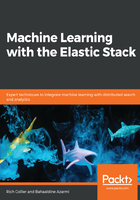
De-trending
Another important aspect of faithfully modeling real-world data is to account for prominent overtone trends and patterns that naturally occur. Does the data ebb and flow hourly and/or daily with more activity during business hours or business days? If so, then this needs to be accounted for. ML automatically hunts for prominent trends in the data (linear growth, cyclical harmonics, and so on), and factors them out. Let's observe the following graph:

Here, the periodic daily cycle is learned, then factored out. The model's prediction boundaries (represented in the light blue envelope around the dark blue signal) dramatically adjusts after automatically detecting three successive iterations of that cycle.
Therefore, as more data is observed over time, the models gain accuracy both from the perspective of the probability distribution function getting more mature, but also via the de-trending of other patterns that might not emerge for days or weeks.